Creating Alarms
This section provides instructions and examples for configuring various types of alarms in Object Configurator.
You want to create a management station alarm that monitors a 32 BitString data point value. For example, the states High limit and Fault could trigger the alarm State (Client profile BA_EN). Both TRUE conditions must be met to trigger the State alarm. All other possible state combinations do not trigger an alarm.
Create Alarm Configuration
- The data point must be type GmsBitString based on PvssBit32 to be able to configure a BitString alarm (see Step 4).

- In System Browser, select Project > Field Networks > [network] > Hardware > [device] > [data point].
NOTE: The folder path may vary by subsystem or view.
- Select the Object Configurator tab.
- In the Properties expander, select the relevant Property (for example, Property Alarm).
- In the Details expander and in the General group box, check the Type. The data type GmsBitString based on PvssBit32 must display in the tool tip.
- In the Alarm Configuration expander, select Valid. The activation is displayed in gray.
- Select the Management Station option.
- The selection for Alarm Type is not possible in the drop-down list.
- (Optional) From the Alarm flags drop-down-list, select None, No alarm on driver invalid, No alarm on source time invalid (for background information, see the alarm configuration reference section).
- Click New for a new alarm class.
- Set the conditions for each alarm class:
a. Select the Alarm Class type.
b. In the Value range column, select the Operand.
c. In the Value range column, select the check box.
d. Open the selection pane and activate the corresponding BitStrings. The activated BitStrings act as an AND condition. All activated BitStrings must be TRUE to trigger an alarm. In the following example, these are Fault (1) and High Limit (2).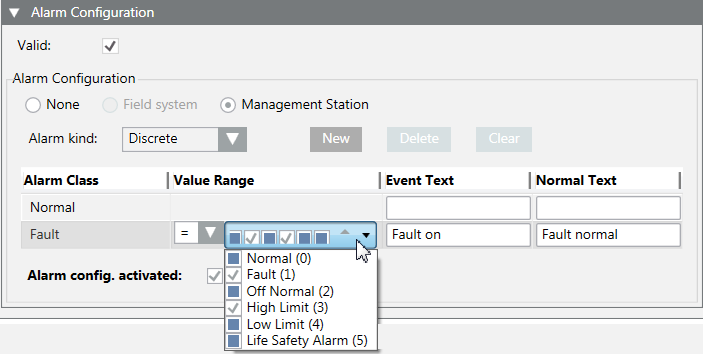 .
.
e. Enter the required information in Alarm text and Normal text fields. Depending on your assigned event profile, the alarm lamps maybe different as in the picture.
f. Select the check box Activate device recognition.
- (Optional) Repeat Step 9 if additional conditions are required.
NOTE: The alarm with the highest alarm priority must be defined at the bottom if multiple alarm conditions are defined because alarm processing occurs from bottom to top. The remaining alarm definitions are no longer evaluated as soon as a condition is met.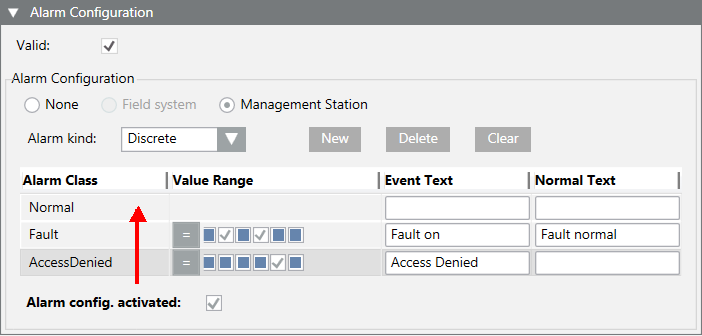
- Click Save
 .
.
- The alarm configuration is concluded and cannot be tested.
Test the Alarm Configuration and Triggering the Alarm
- The object model must have a button for commanding to be tested. Select the object model and define for BACnet BACnetWriteBitString or GenericWriteBitString.
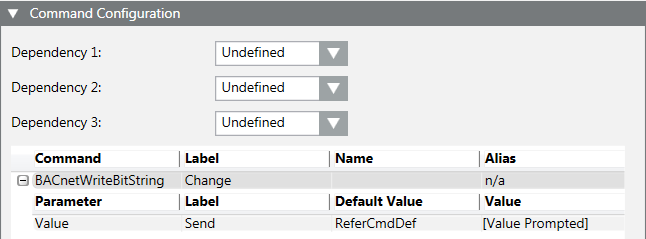
- Select Project > Field Networks > [network name] > Hardware > [device name] > [data point].
NOTE: The folder path may vary by subsystem or view.
- In the Contextual pane:
a. Select the Operation tab.
b. Locate the corresponding property (for example: Property Alarm).
c. In the BitString mask, activate Fault and Top limit (the states are displayed in the tool tip). The selected boxes are displayed in gray. In contrast to alarm configuration, note that the states are displayed from right to left.
d. Click Change.
- The alarm is triggered and displayed in the Summary bar under the alarm category State. In the Cause column, the defined alarm text Fault on as well as the two defined conditions in parenthesis (Top limit Fault) are displayed.

Acknowledge and Reset Alarm
- The alarm is triggered and displayed in alarm category State 1/1.
- In the Summary bar, click alarm category State.
- A filtered alarm list is displayed.
- In the Commands column, click Acknowledge
 .
.
- The next action is displayed in the Alarm state column.
- Select Project > Field Networks > [network name] > Hardware > [device name] > [data point].

- Do the following:
a. In the Contextual pane, click the Operation tab.
b. Select the corresponding property (for example: Property Alarm).
c. In the BitString mask, deactivate Fault and Top limit (the states are displayed in the tool tip). The selected boxes are displayed in white.
d. Click Change.
- In the Commands column, click Reset
 .
.
- The alarm is removed from the Alarm Summary bar and symbol returns to normal state in the Operation tab.

- Select the Detail log tab. The executed commands and resulting states can be printed for logging purposes.

Information on how BitString Alarms Work
- Data type
Only the GmsBitString based on PvssBit32 data type support this alarm function. The data type GmsEnum based on PvssUInt is mostly used in existing libraries; they cannot be used for this BitString alarming.
- Text groups
The referenced text group must be defined in ascending order and without gaps and cannot have more than 32 entries:
− Valid text group: 0, 1, 2, 3, 4, 5
− Invalid text group: 0, 5, 6, 8, 9, 10
Click the check box to display and review a selected text group. An invalid text groups is framed in red.

- Check the content of a text group.
- Select the Object Model.
- In the Details expander, click Text group.
- The Text group editor opens and the content is displayed.

- Evaluation of the BitString masks
In the alarm definition, how the bit must be set for alarming is defined for each bit. An alarm is triggered in the following example only for Situation 2 and Situation 4. The BitString mask no longer matches the alarm definition for Situation 1 and Situation 3.
Example of possible Bit states | ||||||
Text group Fault | Bit | Alarm definition | Situation 1 | Situation 2 | Situation 3 | Situation 4 |
Normal | 0 | 0 | 0 | 0 | 0 | 0 |
Fault | 1 | 1 | 0 | 1 | 1 | 1 |
Off-normal | 2 | 0 | 0 | 0 | 0 | 1 |
High limit | 3 | 1 | 1 | 1 | 0 | 1 |
Low limit | 4 | 0 | 0 | 0 | 0 | 0 |
Pers.-Alarm | 5 | 0 | 0 | 0 | 0 | 0 |
|
|
| − | Alarm | − | Alarm |
If, after an alarm is triggered (Situation 2) another bit change occurs, for example, at bit 2 (Situation 4), the triggered alarm remains pending until acknowledged. The alarm can only be reset if bit 1 and 3 return to state 0.
If bit 2 is set first for situation 4, the alarming only occurs if bit 1 and bit 3 are subsequently set.
You want to set up a management station alarm that monitors a value (for example, > 87).
- You have the appropriate user rights to create an alarm.
- In System Browser, select Project > Field Networks > [network] > Hardware > [device] > [data point].
NOTE: The folder path may vary by subsystem or selected view.
- Select the Object Configurator tab.
- In the Properties expander, select the appropriate property (for example, Present_Value).
- In the Alarm Configuration expander, select the Valid check box to display activation in grey.
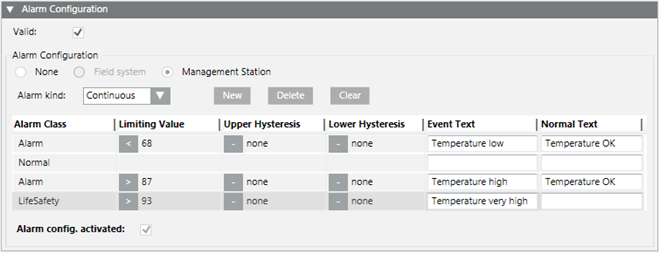
- Select the Management Station option.
- (Optional) From the Alarm flags drop-down-list, select None, No alarm on driver invalid, No alarm on source time invalid (for background information, see the alarm configuration reference section).
- In the Alarm kind drop-down list, select Continuous.
- Click New to define a new alarm class.
- Define the corresponding conditions for each alarm class:
a. Select the Alarm Class type.
b. In the Limiting Value column, select the operand.
c. In the Limiting Value column, select the value.
d. (Optional) Enter the value in the Upper Hysteresis and/or Lower Hysteresis columns. Entering a hysteresis prevents the triggering of an alarm each time there is a slight variation.
e. Enter the necessary information in the Event Text field and Normal Text field. Depending on your assigned event profile, the alarm lamps maybe different as in the picture.
f. Select the Alarm config. activated check box.
- Click Save
 .
.


The limit values are only monitored when the following conditions are met:
- In the Alarm Configuration expander, the Alarm config. activated check box is selected.
- In the Main expander, the Out of scan check box is deselected.
- The entries are saved.
Functionality of Hysteresis
The alarm triggers according to the set threshold value if a Upper Hysteresis and Lower Hysteresis entered on the selected setpoint. Hysteresis allows the user to incorporate tolerance in the alarm levels. In the following image, hysteresis is used to define the alarm conditions.
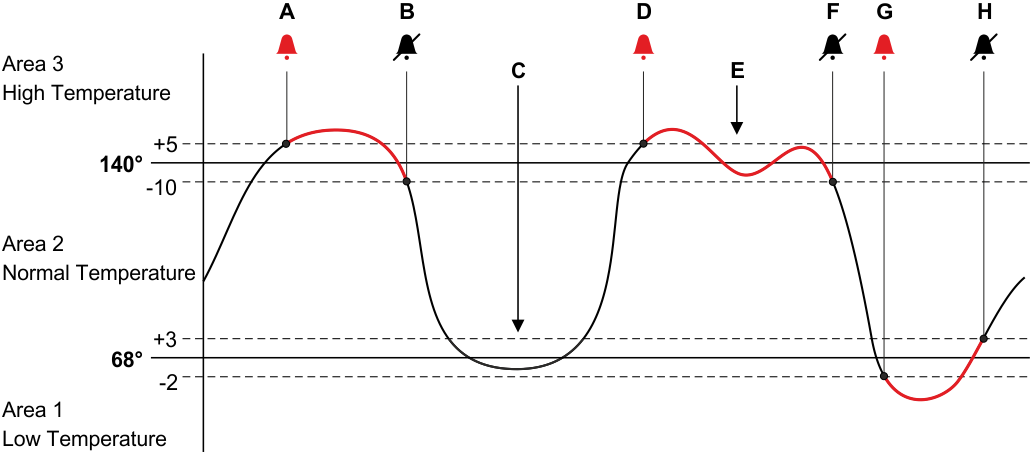
Explanation of Hysteresis Behavior | |
| Description |
A | The point goes into alarm because the value has crossed the Upper Hysteresis of the High Temperature alarm. |
B | The point returns to normal because the value has returned to Normal Temperature. |
C | Notice that the point did not go into alarm as it reached a value lower than the Low Temperature value. Because it did not cross the Lower Hysteresis, it did not trigger the alarm. |
D | The point goes into alarm because, again, the value has crossed the Upper Hysteresis of the High Temperature alarm. |
E | Notice that the point did not come out of alarm as it fluctuated. It remained in alarm until it crossed the Lower Hysteresis. |
F | The point returns to normal because the value has returned to the Normal Temperature condition. |
G | The point goes into alarm because the value has crossed the Lower Hysteresis of the Low Temperature alarm. |
H | The point returns to normal because the value has returned to the Normal Temperature condition. |
Entry of alarm configuration for an alarm high and low:
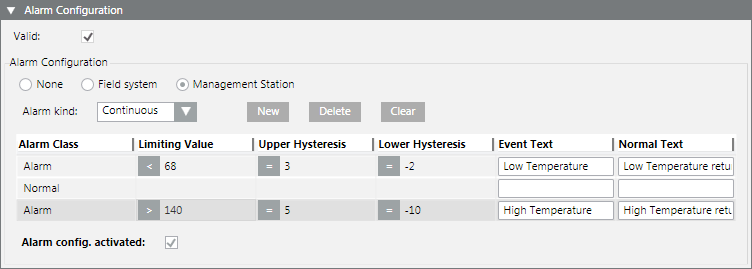
Supported Operands | ||
Operand | Meaning | Example |
> | Greater than |
|
< | Less than |
|
>= | Greater than or equal to |
|
<= | Less than or equal to |
|
Fault indication
- The value sequence is not ascending. A valid value must be less than 50.

Example: Advanced Temperature Monitoring
You can easily create an advanced temperature monitor by selecting the temperature sensor (Present_Value) in System Browser. Define a corresponding message for each temperature limit. The corresponding message is sent out when the set values are reached. Use the Hysteresis columns to avoid triggering additional messages for slight temperature deviations.
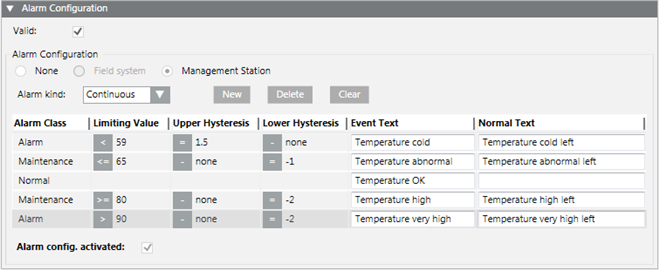

You can define only one normal range. First, create the corresponding number of alarm classes and then select the corresponding position for normal range.
You want to set up a management station alarm that monitors a value or range. For example, 68 ‒ 86 is the normal value range; values that are greater or less than that range will trigger an alarm.
- You have the appropriate user rights to create an alarm.
- Select Project > Field Networks > [network] > Hardware > [device] > [Data point].
NOTE: The folder path may vary by subsystem or selected view.
- Click the Object Configurator tab.
- In the Properties expander, select the appropriate property (for example, Present_Value).
- In the Alarm Configuration expander, select the Valid check box to display activation in grey.

- Select the Management Station option.
- (Optional) From the Alarm flags drop-down-list, select None, No alarm on driver invalid, No alarm on source time invalid (For background information, see the alarm configuration reference section).
- In the Alarm kind drop-down list select Discrete.
- Click New to define a new alarm class.
- Define the corresponding conditions for each alarm class:
a. Select the Alarm Class type.
b. In the Value Range column, select the operand.
c. In the Value Range column, select the values.
For example, the range 100 through 200 and 200 through 300. Entering 100 through 199 and 200 through 299 creates a gap in monitoring from 199.001 to 199.999.
d. Enter the necessary information in the Event Text field and Normal Text field. Depending on your assigned event profile, the alarm lamps maybe different as in the picture
e. Select the Alarm config. activated check box.
- Click Save
 .
.

The limit values are only monitored when the following conditions are met:
- In the Alarm Configuration expander, the Alarm config. activated check box is selected.
- In the Main expander, the Out of scan check box is deselected.
- The entries are saved.
Supported Operands | ||
Operand | Meaning | Example |
> | Greater than |
|
< | Less than |
|
>= | Greater than or equal to |
|
<= | Less than or equal to |
|
Fault indication
- The value sequence is not ascending. A valid value must be less than 50.

Example: Door and Window Monitoring
You can easily monitor a door by selecting the door contact input (Present_Value) in System Browser. Define the open state of the doors. For example, a !|| ACTIVE. A message is sent if the doors are opened.


The operands || or !|| depends on the contact function (normally open, normally closed).
Example: Simple Temperature Monitoring
You can easily create a simple temperature monitor by selecting the temperature sensor (Present _Value) in System Browser. Define the desired comfort temperature range. For example, !.. 68 to 77. The corresponding message is sent out if the value is breached or exceeded.

Example: Level Monitoring
You can easily create a level monitor by selecting the level sensor (Present_Value) in System Browser. Define a corresponding message for each level. The corresponding message is sent out when the set values are reached. In this case, the value for 125, 150 or 200 must be precisely changed to send out a message.
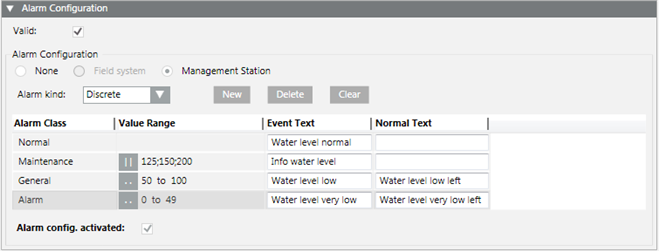

For Uint64 data types, if you configure a discrete alert with a range with maximum higher upper limit (that is, specifying the Max Uint 64: 18446744073709551616), you will only see an event if the property value is 2^63 - 1 (9223372036854775807) or lower. Any higher value of the property will not trigger the alert.




